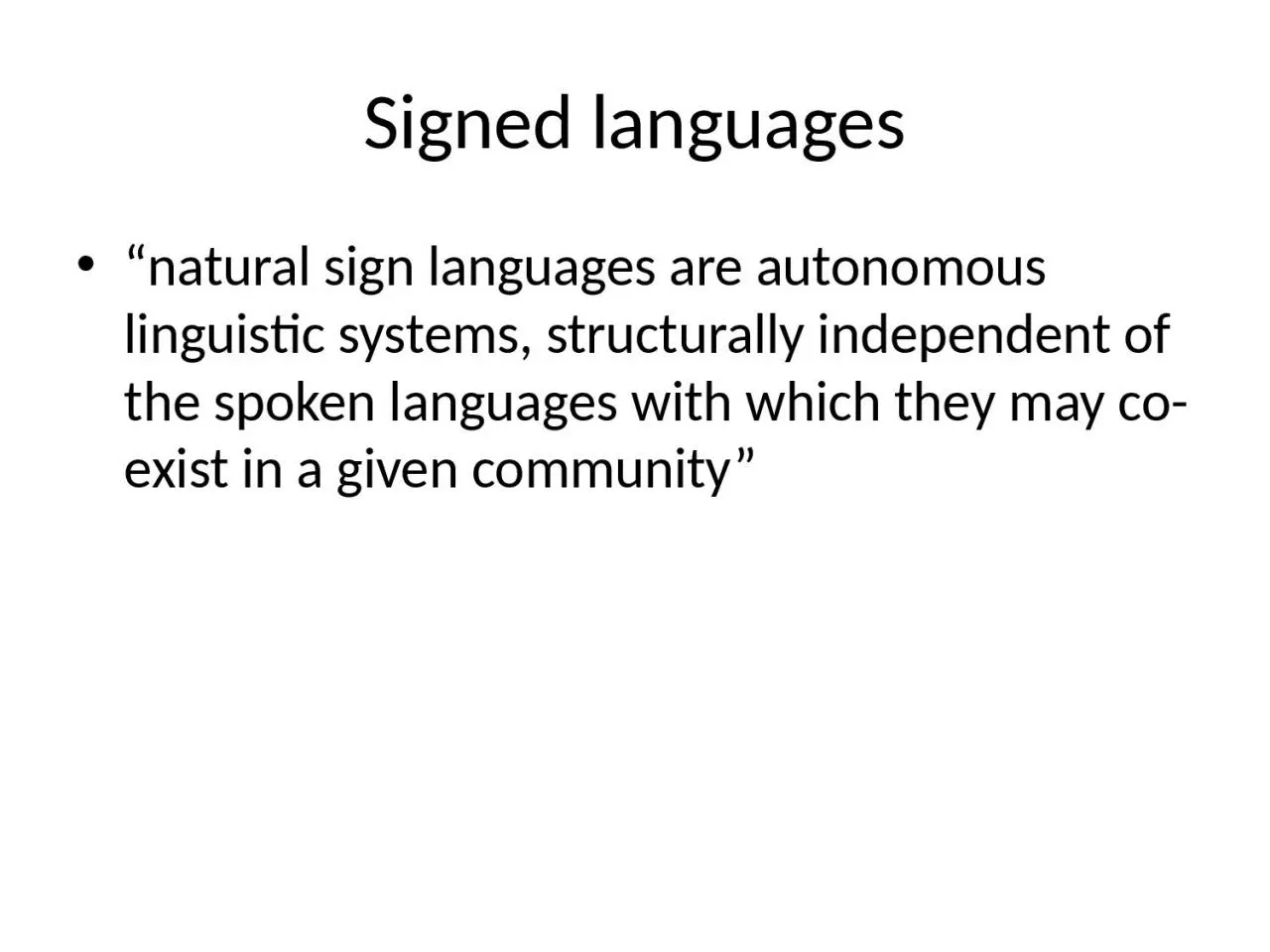

Signed languages LOCATION HAND SHAPE FACIAL EXPRESSIONS Location Hand shape Facial Expressions Signed vs Spoken Language ASL Where ASL is spoken American Sign Language ASL Population 500000 to 2 million Schein 1989 ID: 935820
Download Presentation The PPT/PDF document "Signed languages “natural sign languag..." is the property of its rightful owner. Permission is granted to download and print the materials on this web site for personal, non-commercial use only, and to display it on your personal computer provided you do not modify the materials and that you retain all copyright notices contained in the materials. By downloading content from our website, you accept the terms of this agreement.
Slide1
Signed languages
“natural sign languages are autonomous linguistic systems, structurally independent of the spoken languages with which they may co-exist in a given community”
Slide2Signed languages
LOCATION
HAND SHAPE
FACIAL EXPRESSIONS
Slide3Location
Slide4Handshape
Slide5Facial Expressions
Slide6Slide7Signed vs. Spoken Language
Slide8Slide9ASL
Slide10Where ASL is spoken
Slide11American Sign Language (ASL)
Population: 500,000 to 2 million (Schein 1989)
Developed at the American School for the Deaf in Connecticut (founded in 1817)
Strong influence from French Sign Language (FSL)
58% of ASL signs can be traced back to FSL origins
Also influenced by Martha’s Vineyard Sign Language
High percentage of deaf Islanders
Slide12Pause point 1
What did you know already about signed languages going into this reading?
Was it from personal experience, learning about it at school, or exposure on (social) media…?
Were there any misconceptions or misbeliefs you had about signed languages coming into this reading that were corrected or clarified by the article?
Slide13Discrimination against signers
ASL used to be banned in schools, and deaf children punished for signing
Racial segregation in Deaf schools lasted significantly longer than in hearing schools
Black and white deaf children were segregated up till the 1970s
Slide14Discrimination against signers
Debate over whether or not deaf children should be taught to speak, be given cochlear implants, or learn only to sign
Slide15Slide16Pause point 2
Check out this essay about the viral videos of people (often babies) hearing for the first time due to cochlear implants (and go as far down the
rabbithole
as you’d like, since there are a number of additional videos & links on this page) and share with us your thoughts and reactions
What is audism? What is the case the author makes about these videos being an example of audism?
Does it deprive Deaf children of connection to Deaf culture to avoid teaching them a signed language and center on restoring their hearing ability?
What should we do when we see these videos circulating?
https://www.dailydot.com/irl/viral-videos-hearing-deaf-culture/
Slide17Slide18Variation in signing
There is variation in signing
handshapes
and movements just like spoken language features variation in pronunciation
Slide19Slide20Variation in ASL
One-handed vs. two-handed variants: DEER
Slide21Variation in ASL
Assimilation: TOMATO
Slide22Variation in ASL
Assimilation: TOMATO
Slide23Variation in ASL
Deletion: SNOW
Slide24Slide25Variation in ASL
Variation based on formality (e.g. KNOW)
Slide26Variation in ASL
Regional variation (e.g. FOOTBALL)
Slide27Variation in ASL
Ethnic variation (e.g. WELL-DRESSED)
Slide28Black ASL
Slide29Pause point 3
Find out more about Black ASL by reading one of these pieces, finding a Black signer on
Tiktok
(share the videos if you go this route!), googling “Carolyn McCaskill”, or watching
Signing Black in America…
https://www.nytimes.com/2021/01/23/us/black-american-sign-language-tiktok.html
https://www.theatlantic.com/business/archive/2017/08/gallaudet-franklin-jones-carolyn-mccaskill/536949/
https://www.washingtonpost.com/lifestyle/style/sign-language-that-african-americans-use-is-different-from-that-of-whites/2012/09/17/
https://www.youtube.com/watch?v=oiLltM1tJ9M
(
Signing Black in America
; run time ~30 mins)
What did you learn? What can you share? How did it align with, echo, or diverge from the points in the reading?